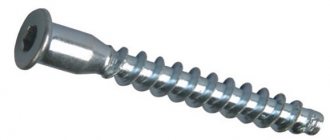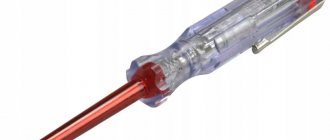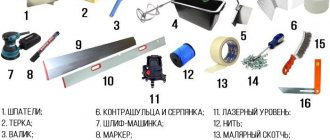| Place | Name | Characteristics in the rating |
| The best roller glass cutters |
| 1 | Matrix 87264 | The most comfortable model |
| 2 | BISON Expert 33684 | The best combination of price and quality |
| 3 | STANLEY 0-14-040 | High quality and reliability |
| 4 | STAYER 8000 M 3369 | Great option for home use |
| 5 | FIT | Inexpensive glass cutter of good quality |
| The best diamond glass cutters |
| 1 | SPARTA 872405 | The most comfortable handle |
| 2 | BISON Expert 3362 | Best tool for home use |
| 3 | Brigadier Extrema | The smoothest cut |
| 4 | COBALT 911-130 | Great resource, convenience |
| 5 | Ermak | Inexpensive option for personal use |
Glass cutters are needed not only by professional craftsmen. For owners who are used to doing everything themselves, this tool is always in a drawer with other tools that may be useful for housework. The most famous are diamond glass cutters. They appeared a long time ago and still do not lose popularity. No less common are roller models, characterized by practicality and durability. If you need to purchase this tool, but you don’t know which one to choose, check out the rating of the best glass cutters.
The best roller glass cutters
In tools of this category, special rollers made of a very durable cobalt-tungsten alloy are responsible for cutting. Their number can be different - from one to six. The tool is quite popular because of its practicality. If you have to use it infrequently, then there will be no need to purchase it again - it lasts for a very long time. More modern models include roller oil glass cutters. They work on the same principle, but are more convenient to use and smooth running due to the constant supply of a small amount of oil, which is poured into a specially designed handle.
Purpose
Whatever object you use: a semi-automatic table for cutting glass or a manual device, the essence of their functioning is the same - applying a direct scratch to the surface, along which a break occurs manually. In addition to glass, popular models successfully cope with tiles, ceramics, and corrugated glass bases.
When working with corrugated glass, the cut is made from the smooth side. It is not recommended to cut tempered glass. The slightest damage leads to their disintegration into tiny particles.
The best diamond glass cutters
Diamond glass cutters can be called classics - they appeared on sale a very long time ago, but still do not lose their relevance due to their excellent cutting properties and long service life. Usually a stone of synthetic origin is used, but it is very durable, due to which the most even cut line is achieved, which does not require adjustment. It is somewhat more difficult for a beginner to work with a diamond glass cutter compared to roller models, but this type of tool can be called almost eternal.
Top 10 rating according to KP
The hand glass cutter is perhaps the most innocuous looking tool ever created. Resembling a medieval toothbrush, it consists of a cast metal handle with a round ball at one end and a toothed head at the other end, fitted with a tiny steel cutting wheel.
Not all glass cutters are designed to perform the same function. There are tools designed only for cutting plexiglass, glass bottles or for cutting circles on mirrors. KP has compiled a rating of the top 10 best universal glass cutters. When choosing, we paid attention to the comfort of the handle and the material of the cutting head. In addition, we noted the functionality of the tools and their cost. Today there are dozens of models of glass cutters on the market, but we relied exclusively on proven tools.
If you liked the article, please share it
Previously on the topic:
Share
What does a skilled glazier do while performing a job?
- When making cuts, the force along the entire path of movement of the glass cutter is constant - the vertical pressure does not change from the beginning to the end of the movement of the tool. The speed also remains unchanged. No stops are allowed and the line is not interrupted.
- Between making the groove and subsequent actions, a minimum of movement and time is needed. Then cooling in the groove will not occur; the risk itself will not have time to be covered with glassy tissue. A specialist will spend no more than 2…3 seconds on a fracture.
- A second or third movement is not allowed. If this happens, the material breaks along several lines and an even single edge is not formed. Sometimes a mesh may form and a defect will occur.
- To perform the cut, a high-quality glass cutter is used, which is installed at a certain optimal angle to the glass surface and to the direction of longitudinal movement.
The glass cutters themselves are produced using different technologies. A skilled glassmaker has several examples in his arsenal. The choice depends on a number of factors that should be considered before starting work.
Question answer
What kind of oil to pour into an oil glass cutter
The quality of the oil has a direct impact on the performance of the glass cutter. Therefore, the choice of product must be taken responsibly. A lubricated roller ensures smooth movement and collects glass dust. Using a lubricant extends the life of the tool.
To maintain an oil glass cutter, it is recommended to purchase special compounds. The recommended ones include:
- Milli M2000;
- Bohle;
- Novacan Cutter Oil;
- Acecut 5503;
- T-3133.
They have a special consistency, are easily removed from the glass surface, evaporate quickly, and do not spread. They are used, as a rule, when performing professional cutting, when the issue of chip quality is paramount.
Lubricant for the tool is selected taking into account the thickness and strength of the material. At home, it is enough to use Vaseline or spindle oil. The consistency of the composition should be liquid so that the cutter can easily follow the markings. The following options are considered as substitutes: kerosene, white spirit, turpentine. It is prohibited to use machine or sunflower oil for glass cutting.
Which side to cut a mirror with a glass cutter
To cut mirrors, both a regular roller glass cutter and a diamond type of tool are used. The main thing is that the cutting part is made of carbide material and is well sharpened.
The mirror cloth is laid on a flat surface. After this, make markings with a ruler and marker. Sliding with a glass cutter is performed in reverse. All actions are performed on the front side of the mirror (the one that provides the reflective effect). The passage of the glass cutter is carried out with a confident and fast movement.
The principle underlying the technology of mechanical glass cutting
Let’s immediately make a reservation that in the future we will talk about cutting ordinary quartz window glass. The same one that you most often encounter during construction or repair work.
The remark is made for the reason that there are other types of materials whose names include the term “glass”. Thus, tempered glass, that is, glass that has undergone special treatment to reduce fragility, cannot be cut at home, without special equipment. The same applies to multilayer materials – triplexes. For example, what we often call plexiglass, in fact, is not glass at all, and completely different cutting tools are used to cut it.
As a rule, in everyday practice during repairs or construction one has to deal with window silicate glass obtained from a melt of quartz rocks and special additives
So, ordinary window glass is produced using technology known since ancient times. It is obtained using the technology of melting quartz rocks (most often it is purified quartz sand). The content of silicon dioxide SiO₂ in the finished product reaches almost 70÷75%.
Chemical resistance and characteristic shine of glass are given by calcium oxide (CaO), which at different historical stages of glass production was added to the melt in the form of crushed sea shells, chalk, and lime.
Finally, another essential component is the oxides of alkaline metals. For this purpose, soda or potash is added to the quartz melt, which decomposes to oxides under high temperature influence.
The melt is formed and then cooled using a special technology that prevents the crystallization process. And the result is a glassy state of the substance, which has the properties of a solid, but at the same time partially retains the qualities of a superviscous liquid. This state is usually called amorphous.
With the same chemical composition, there is a significant difference in the molecular structure of solid quartz and amorphous glass based on it
Yes, it may seem strange, but solid glass still has a certain degree of fluidity. You should not be afraid of this circumstance - any noticeable changes in size occur over many decades and even centuries. But this property still leaves a certain imprint on glass cutting technology - this will be discussed below.
A characteristic feature of glass is its increased fragility (almost two orders of magnitude higher than that of iron). It is almost impossible to deform glass at temperatures below its melting level - it is destroyed by mechanical stress.
At the same time, ordinary silicate glass has good hardness indicators, almost as good as the original material - quartz.
It’s worth saying a little more about the hardness of materials, since it is this parameter that determines the possibility of cutting glass.
There is the so-called Mohs scale, which compares the hardness of substances with ten natural reference minerals. The bottom step is occupied by natural talc, which is not at all durable, and is easy to scratch even with the force of a fingernail. At the top of the scale is the diamond, the strongest known natural formation.
Prices for glass cutters
glass cutter
Visual representation of the Mohs scale. In terms of strength, glass occupies approximately the same position as quartz.
It is clear that in order to be able to cut this or that material, it is necessary to use a tool that would be located higher on this scale. And the optimal solution, universal for processing any materials, is diamond.
By the way, the scale does not give the perception of hardness correctly enough. One should not think that digital designations are somehow related to absolute hardness indicators. So, for example, between the seventh place (quartz, glass) and the tenth (diamond) the difference is 15÷16 times. And even corundum, which ranks ninth, is almost 4 times less hard than diamond.
But let's return to the glass. The process of its mechanical cutting is as follows. According to the markings applied on the glass sheet, a mark is applied. In essence, it is a deep scratch (groove) caused by a material that is significantly stronger than glass in hardness.
The first step in glass cutting technology is to apply a groove that defines the cutting line.
With this scratching, a tiny network of intersecting cracks is created on the surface. At the same time, there is a sharp increase in internal stresses, leading to the growth of these cracks. Naturally, these stresses reach their peak values precisely along the cut line, which is facilitated by the wedging effect of a correctly sharpened cutter.
The second step is that the glass should break off evenly along the groove applied (this is shown as an example, but you should not neglect gloves during the work).
If the mark was applied efficiently, with the necessary force and uniformity, then when a force perpendicular to the cutting line is applied, a fracture should occur. It is very important that there should not be a long pause between applying the marks and breaking the glass. It was already mentioned above about the amorphous nature of glass, and a thin scratch tends, so to speak, to “linger.” This, of course, is completely invisible to the eye, but a process of some normalization of the created stresses occurs, the grooves melt, and it becomes much more difficult to produce a high-quality fracture.
And one more very important nuance regarding cutting technology. In order for the internal stresses created in the sheet glass to contribute to the appearance and propagation of a crack deeper and strictly along the line, that is, even spalling of the material, the groove must be applied in one precise movement, with well-set uniform speed and pressure. Two or more passes will not improve the situation at all. On the contrary, with a high degree of probability one can expect the appearance and propagation of lateral cracks, which at best will lead to an uneven edge, and at worst to final damage to the material.
So, it is quite obvious that to complete the first step you need a special tool capable of making a high-quality groove of the required depth along the cut line. This tool is just a glass cutter.











